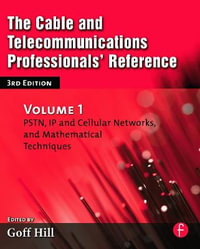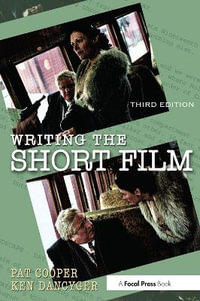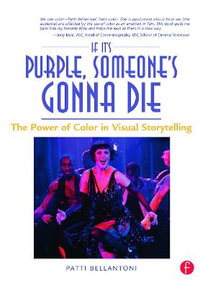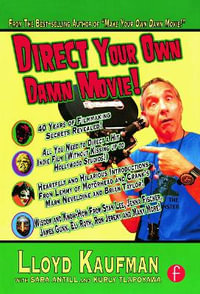
Film Into Video
A Guide to Merging the Technologies
Paperback | 11 April 2000 | Edition Number 2
At a Glance
412 Pages
New edition
26.2 x 18.8 x 2.8
Paperback
RRP $189.00
$138.25
27%OFF
or 4 interest-free payments of $34.56 with
orAims to ship in 7 to 10 business days
Additions to the second edition include: information on the Philips Spirit Data Cine and the new Sony FVS-1000; a new section on the latest in flying spot telecines, including Cintel's C-Reality and Ursa Electrum; an examination of recent changes in color correction computers with da Vinci's 2K and Pandora's Mega-Def systems, and in respect to Philips Spirit DataCine and Cintel's C-Reality, a discussion relating to the area of data transfer and how this has changed the telecine industry.
New information on the Philips Spirit Data Cine and the new Sony FVS-1000
A new section on the latest in flying spot telecines, including Cintel's C-Reality and Ursa Electrum
Covers recent changes in color correction computers with da Vinci's 2K and Pandora's Mega-Def systems
Industry Reviews
"If you work with film-to-video transfer equipment, are interested in film-to-video transfer or just enjoy learning about the history and current technology of film and video equipment, you will definitely enjoy Film into Video, Second Edition." - Don Smith, Videomaker
Praise for the previous edition: "An excellent reference book detailing all aspects of how the professional would go about transferring film to video, costing such a job, the time scales involved and the creative sides to post-production." - Amateur Film & Video Maker (IAC)
| Preface | p. xv |
| Acknowledgments | p. xvii |
| Film and Video: A Brief History | p. 1 |
| Assets of Film and Video | p. 1 |
| The Film-Video Interface | p. 2 |
| Summary | p. 4 |
| Film Technology | p. 5 |
| The Physics of the Film Medium | p. 5 |
| Film Stock Construction | p. 5 |
| Image Formation | p. 8 |
| Film Parameters | p. 8 |
| Grain and Sensitivity | p. 9 |
| Sensitometry and Contrast Ratio | p. 10 |
| Resolution | p. 10 |
| Additional Characteristics of Film Systems | p. 11 |
| Film Formats | p. 13 |
| 35mm Film | p. 14 |
| 16mm Film | p. 17 |
| 8mm Film | p. 20 |
| Summary | p. 22 |
| Video Technology | p. 23 |
| General Video Parameters | p. 23 |
| Luminance | p. 24 |
| Chrominance | p. 25 |
| Hue | p. 25 |
| Scanning Systems | p. 25 |
| Resolution | p. 26 |
| Bandwidth | p. 27 |
| Synchronization | p. 27 |
| Measurement of Video Parameters | p. 28 |
| Video Configurations | p. 29 |
| Component Video | p. 29 |
| Composite Video | p. 30 |
| Analog Video | p. 31 |
| Digital Video | p. 32 |
| International Technical Standards | p. 33 |
| 525/60 NTSC | p. 34 |
| 625/50 PAL | p. 35 |
| Other Systems | p. 36 |
| HDTV | p. 36 |
| Summary | p. 38 |
| Film into Video | p. 39 |
| The Film-Video "Fit" | p. 39 |
| Frame-Rate Conversion | p. 40 |
| 525/60 Video Systems | p. 40 |
| 625/50 Video Systems | p. 42 |
| Nonstandard Film Speeds | p. 42 |
| Image Size Conversion | p. 42 |
| Academy Film Format (1.33:1) | p. 42 |
| Wide-Screen Formats | p. 43 |
| Contrast | p. 45 |
| Gamma Differences | p. 46 |
| Resolution | p. 47 |
| Comparison of Film and Video Resolution | p. 48 |
| Summary | p. 49 |
| Telecine Devices | p. 51 |
| History and Overview | p. 51 |
| Vidicon Camera Telecines | p. 51 |
| Flying Spot Scanners | p. 53 |
| Charge-Coupled Array Telecines | p. 54 |
| Current Telecine Systems | p. 55 |
| Flying Spot Scanner Telecines | p. 55 |
| General Features | p. 55 |
| Disadvantages | p. 57 |
| The Cintel Mark III Telecine | p. 58 |
| Film Formats | p. 58 |
| Video Formats | p. 59 |
| Transport | p. 60 |
| Specific Limitations | p. 60 |
| The Ursa | p. 60 |
| The Ursa Gold | p. 61 |
| The Ursa Diamond | p. 61 |
| The Ursa Electrum | p. 62 |
| The C-Reality | p. 62 |
| Flying Spot Telecine: A Detailed Theory of Operation | p. 64 |
| Transport | p. 64 |
| Video System | p. 68 |
| Charge-Coupled Device Telecines | p. 75 |
| General Features | p. 75 |
| The Philips FDL 90 CCD Telecine | p. 76 |
| Film Formats | p. 76 |
| Video Formats | p. 76 |
| Transport | p. 77 |
| Specific Limitations | p. 78 |
| Philips FDL 90 Detailed Theory of Operation | p. 78 |
| Transport | p. 79 |
| Video System | p. 80 |
| The Philips Spirit DataCine | p. 83 |
| Film Formats | p. 84 |
| The Sony FVS-1000 Vialta | p. 87 |
| Film Formats | p. 87 |
| Video Formats | p. 87 |
| Transport | p. 87 |
| Image Manipulation | p. 87 |
| Camera-Type Telecines | p. 88 |
| Sondor OMA-S Telecine | p. 88 |
| Summary | p. 89 |
| Video Recorder Formats | p. 91 |
| Digital Tape Recorder Formats | p. 92 |
| D-1 (4:2:2) Format | p. 94 |
| D-2 (4 Fsc) Format | p. 95 |
| D-3 (4 Fsc) Format | p. 97 |
| D-5 (4:2:2) Format | p. 98 |
| D-6 Format | p. 98 |
| Digital Betacam (4:2:2) Format | p. 99 |
| HDCam | p. 100 |
| DCT (4:2:2) Format | p. 101 |
| Digital Magnetic Disk Recorders | p. 101 |
| Analog Recorder Formats | p. 103 |
| 1-Inch Type C | p. 104 |
| 1-Inch Type B | p. 106 |
| U-Matic | p. 107 |
| Betacam | p. 109 |
| Betacam SP | p. 110 |
| VHS and Super VHS | p. 111 |
| Optical Discs | p. 113 |
| Optical Disc Formats | p. 115 |
| Laser Disc Applications | p. 116 |
| Sound Formats | p. 119 |
| Sound Fidelity | p. 119 |
| Frequency Response | p. 120 |
| Distortion | p. 120 |
| Noise | p. 121 |
| Synchronization | p. 122 |
| Professional Magnetic Tape Formats for Telecine | p. 124 |
| Resolving Systems for Magnetic Tape | p. 126 |
| Wired Sync Systems | p. 126 |
| Crystal Reference Systems | p. 126 |
| Time Code Reference Systems | p. 127 |
| Magnetic Film Formats | p. 128 |
| Professional Magnetic Film Formats | p. 128 |
| Fidelity of Magnetic Film Recordings | p. 133 |
| Optical Sound | p. 134 |
| Optical Sound Systems | p. 134 |
| Dolby Systems | p. 135 |
| Dolby A | p. 136 |
| Dolby SR | p. 137 |
| Dolby Stereo | p. 137 |
| Dolby Optical | p. 138 |
| Recent Changes in Sound Formats for Film | p. 139 |
| Digital Audio Recorders for Production Recording | p. 139 |
| Increased Use of Magnetic Tape for Film Post-Production | p. 139 |
| Digital Optical Sound for Release Prints | p. 140 |
| Summary | p. 142 |
| Sound Transfer Devices and Applications | p. 143 |
| Magnetic Tape Devices | p. 145 |
| Typical Magnetic Audiotape Transport for Telecine | p. 145 |
| Other Magnetic Tape Systems | p. 146 |
| The DAT or Digital Audiotape Recorder | p. 147 |
| Synchronizing and Resolving with Audiotape Transports | p. 150 |
| Synchronizing | p. 151 |
| Resolving | p. 155 |
| Magnetic Film Devices | p. 161 |
| Operational Adjustments and Use of Magnetic Film Tracks | p. 163 |
| Dolby Playback for Magnetic Film Tracks | p. 167 |
| Mixing Levels at the Console | p. 168 |
| Synchronizing and Resolving of Magnetic Film | p. 169 |
| Optical Sound Devices | p. 172 |
| Optical Sound Pickups | p. 172 |
| The Optical Track Follower | p. 174 |
| Video Frame Delay | p. 174 |
| Audio Control and Processing Devices in the Telecine | p. 175 |
| Audio Processors | p. 175 |
| Consoles and Mixers | p. 177 |
| Audio Monitoring Systems | p. 177 |
| Summary | p. 179 |
| Supporting Devices | p. 181 |
| Computer-Based Color Correctors | p. 181 |
| What Do Color-Correction Computers Do? | p. 182 |
| Current Devices | p. 183 |
| Specific Functions of Color-Correction Computers | p. 184 |
| Correction List Management | p. 186 |
| Still Stores | p. 187 |
| In-line Processors | p. 188 |
| Image Enhancers | p. 189 |
| Noise and Film Grain Reducers | p. 190 |
| Encoders | p. 192 |
| Video Switchers | p. 193 |
| Video Key and Matte Systems | p. 193 |
| Video Title Generators | p. 195 |
| Reticle Generators | p. 196 |
| Telecine Transport Controllers | p. 196 |
| Objectives of Telecine Transport Controllers | p. 198 |
| Commonly Used Functions of Telecine Transport Controllers | p. 200 |
| Time Code Generators | p. 203 |
| Film Code Readers | p. 205 |
| Keykode | p. 206 |
| AatonCode | p. 206 |
| Arri Fis | p. 209 |
| Time Code Character Generators | p. 209 |
| Logging Systems | p. 210 |
| Video Printers | p. 211 |
| Wet Gates | p. 211 |
| Pin Registration Image-stabilization Systems | p. 211 |
| Mechanical Systems | p. 212 |
| Electronic Systems | p. 213 |
| Film Cleaners | p. 213 |
| Off-transport Cleaners | p. 213 |
| On-transport Cleaners | p. 216 |
| Planning for Film-to-Video Transfers | p. 219 |
| Planning and Preparation for Transferring the Negative | p. 219 |
| First Step: Getting the Film Safely to the Lab | p. 220 |
| What the Lab Does with the Negative | p. 220 |
| Telecine Prep | p. 221 |
| Planning Considerations for the Telecine | p. 222 |
| Sample Terminology for Roll Identification | p. 225 |
| Transfer from Intermediate and Print Elements | p. 227 |
| Intermediate and Print Elements for the Telecine | p. 228 |
| Print Flaws Relative to Telecine Transfer | p. 230 |
| Quality Control in Video Finishing | p. 233 |
| Relationship with the Lab | p. 233 |
| Business Practices | p. 234 |
| Video Facilities and Costs | p. 235 |
| Evaluating and Selecting a Transfer Facility | p. 236 |
| Level of Service | p. 236 |
| Personnel | p. 236 |
| Equipment | p. 236 |
| Track Record | p. 236 |
| Referral | p. 236 |
| Price | p. 237 |
| Availability | p. 237 |
| Technical Requirements | p. 237 |
| Specialization | p. 237 |
| Security | p. 237 |
| Budgeting and Costs | p. 237 |
| Determining Requirements | p. 238 |
| Estimating Time | p. 238 |
| Budget Limits | p. 239 |
| Bids | p. 240 |
| Facility Rate Structures | p. 240 |
| Inclusions and Exclusions | p. 241 |
| Additional Factors Affecting Transfer Costs | p. 242 |
| Scheduling Facility Time | p. 245 |
| Sources of Information About Facilities | p. 245 |
| Staff Roles | p. 246 |
| Making the Booking | p. 247 |
| Confirmation | p. 248 |
| Facility Business Practices | p. 248 |
| Billing Policy | p. 248 |
| Payment | p. 250 |
| Liability and Security | p. 251 |
| Protection of Materials | p. 251 |
| Satisfaction | p. 252 |
| Problems and Solutions | p. 253 |
| Summary | p. 254 |
| The Telecine Environment | p. 255 |
| The Physical Environment | p. 255 |
| The Room | p. 255 |
| The Console | p. 256 |
| Primary Tools | p. 257 |
| The Creative Environment | p. 261 |
| Responsibilities of Individuals | p. 262 |
| Working Relationships | p. 264 |
| Typical Interrelationships During the Transfer Process | p. 268 |
| Telecine Methods and Techniques | p. 273 |
| Technique | p. 273 |
| What Can Be Taught? | p. 274 |
| What Cannot Be Taught? | p. 275 |
| The Essentials of Technique | p. 276 |
| Know the Capabilities of the Equipment | p. 276 |
| Identify the Desired Results | p. 276 |
| Manage the Process | p. 276 |
| Achievable Goals | p. 277 |
| Reproduce Accurately What Was Shot | p. 277 |
| Compensate for Unavoidable Technical Variations | p. 277 |
| Compensate for Film Errors | p. 278 |
| Optimize Transfer for Use of Special Effects | p. 278 |
| Create a Look or Image | p. 279 |
| Telecine Controls | p. 280 |
| Initializing Controls | p. 280 |
| Image Geometry Controls | p. 282 |
| Video Controls | p. 285 |
| Practical Application | p. 287 |
| Film-Transport Controls | p. 288 |
| Color Correction and Matching | p. 291 |
| Secondary Color Correction | p. 291 |
| Using the Color-Correction Computer | p. 292 |
| Using a Telecine Machine Controller | p. 297 |
| A Simple Transfer | p. 297 |
| A More Complex Transfer | p. 297 |
| Using the Controller for Calculations | p. 298 |
| Macro Functions | p. 501 |
| Five Sample Scenarios | p. 303 |
| Feature Film Transfer on a Limited Budget | p. 303 |
| Monday | p. 303 |
| Tuesday | p. 306 |
| Wednesday | p. 307 |
| Music Video Transfer | p. 308 |
| Friday | p. 308 |
| Saturday | p. 310 |
| Dailies Transfer for a Television Series | p. 311 |
| Wednesday | p. 311 |
| Friday | p. 314 |
| Thursday--Transfer Day 1 | p. 314 |
| Friday--Transfer Day 2 | p. 316 |
| "A" Feature Transfer | p. 317 |
| Wednesday | p. 317 |
| Thursday | p. 318 |
| Friday--Transfer Day 1 | p. 318 |
| Monday--Transfer Day 2 | p. 319 |
| Tuesday--Transfer Day 3 | p. 321 |
| Wednesday--Transfer Day 4 | p. 322 |
| Thursday--Transfer Day 5 | p. 322 |
| Friday--Transfer Day 6 | p. 322 |
| Monday--Transfer Day 7 | p. 323 |
| Tuesday--Transfer Day 8 | p. 323 |
| Wednesday--Holiday | p. 324 |
| Thursday--Transfer Day 9 | p. 324 |
| Friday--Transfer Day 10 | p. 324 |
| Monday--Transfer Day 11 | p. 325 |
| Tuesday--Transfer Day 12 | p. 326 |
| Wednesday--Transfer Day 13 | p. 326 |
| Thursday--Transfer Day 14 | p. 326 |
| Friday--Transfer Day 15 | p. 326 |
| Commercial Video Transfer | p. 327 |
| Monday--Transfer Day 1 | p. 327 |
| Video-to-Film | p. 329 |
| Video-to-Film Equipment and Processes | p. 329 |
| Kinescope | p. 329 |
| Electron Beam Recorder | p. 330 |
| Laser Scanner | p. 331 |
| Proprietary Systems | p. 332 |
| Applications of Video-to-Film Technology | p. 332 |
| Film Prints for Foreign Markets | p. 332 |
| Contractual Requirements | p. 333 |
| Dailies for Sound-Scoring Stages | p. 333 |
| Slides | p. 333 |
| Storyboards, Presentations, and Archives | p. 333 |
| Planning Considerations for Video-to-Film Transfers | p. 334 |
| Video Source Material | p. 334 |
| Film Format and Processing | p. 334 |
| Sound Tracks | p. 335 |
| Tests and Consultation | p. 335 |
| Quality of Video-to-Film Transfers | p. 335 |
| Recent Applications For Video-to-Film Systems | p. 336 |
| Electronic Film Systems Now and Beyond | p. 339 |
| Cintel Ursa Transfer Speeds | p. 341 |
| Philips Spirit DataCine Transfer Speeds | p. 343 |
| Appendix C | p. 345 |
| Appendix D | p. 347 |
| Glossary | p. 349 |
| Index | p. 383 |
| Table of Contents provided by Syndetics. All Rights Reserved. |
ISBN: 9780240804118
ISBN-10: 0240804112
Published: 11th April 2000
Format: Paperback
Language: English
Number of Pages: 412
Audience: Professional and Scholarly
Publisher: Taylor & Francis Ltd
Country of Publication: GB
Edition Number: 2
Edition Type: New edition
Dimensions (cm): 26.2 x 18.8 x 2.8
Weight (kg): 0.92
Shipping
| Standard Shipping | Express Shipping | |
|---|---|---|
| Metro postcodes: | $9.99 | $14.95 |
| Regional postcodes: | $9.99 | $14.95 |
| Rural postcodes: | $9.99 | $14.95 |
How to return your order
At Booktopia, we offer hassle-free returns in accordance with our returns policy. If you wish to return an item, please get in touch with Booktopia Customer Care.
Additional postage charges may be applicable.
Defective items
If there is a problem with any of the items received for your order then the Booktopia Customer Care team is ready to assist you.
For more info please visit our Help Centre.
You Can Find This Book In

The Cable and Telecommunications Professionals' Reference
PSTN, IP and Cellular Networks, and Mathematical Techniques 3rd Edition
Paperback
RRP $152.00
$113.50
OFF
This product is categorised by
- Non-FictionArts & EntertainmentPhotography & PhotographsSpecial Kinds of PhotographyCinematography
- Non-FictionEngineering & TechnologyElectronics & Communications EngineeringCommunications Engineering & TelecommunicationsTelevision Technology
- Non-FictionArts & EntertainmentPhotography & PhotographsSpecial Kinds of PhotographyVideo Photography
- Kids & Children's BooksChildren's Non-FictionDrama & Performing for Children & Teenagers
- Non-FictionSociety & CultureMedia Studies
- Non-FictionArts & EntertainmentFilm, TV & RadioTelevision
- Non-FictionArts & EntertainmentFilm, TV & RadioSpecific Films
- Non-FictionArts & EntertainmentGeneral Issues in Art






















